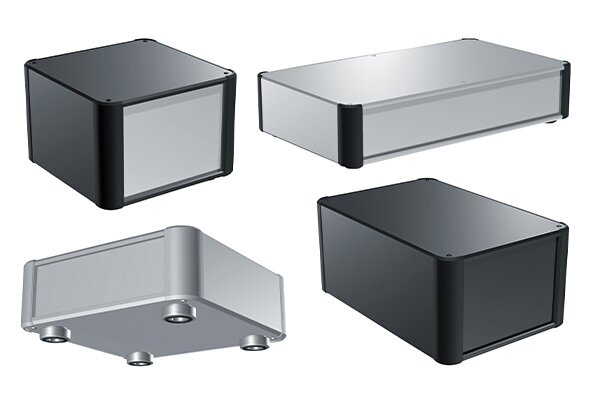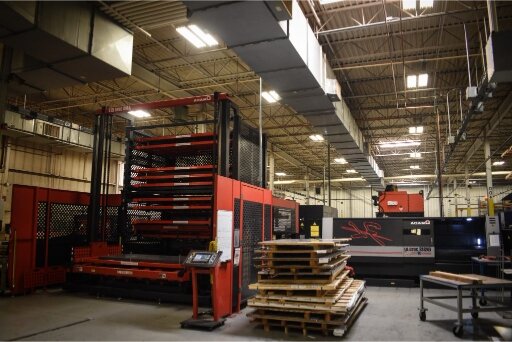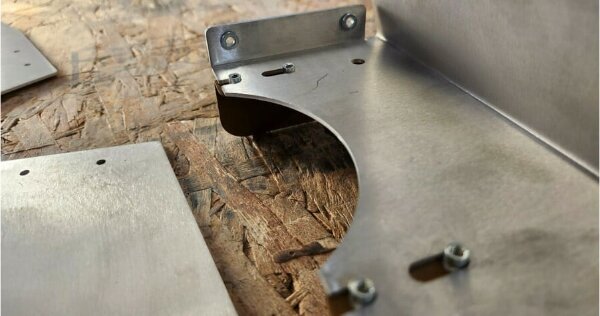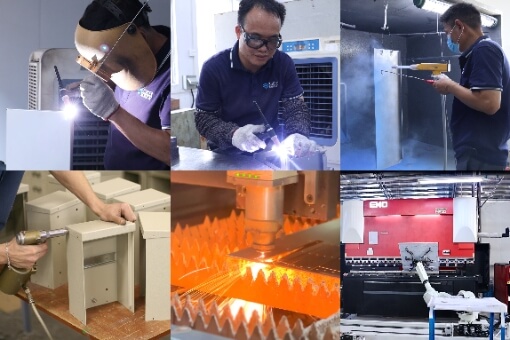Stahl rostet, wenn er mit Luft und Wasser in Berührung kommt, was bei vielen Metallprojekten zu Problemen führt. Wenn Sie Produkte herstellen, brauchen Sie Stahl, der den harten Bedingungen standhält. Galvanisch verzinkter Stahl und verzinkter Stahl sind beide mit einer Schutzschicht versehen. Um die richtige Wahl zu treffen, ist es hilfreich zu wissen, wie die einzelnen Arten funktionieren und wo sie am effektivsten sind.
Verzinkter Stahl hat eine reine Zinkbeschichtung, die einen starken Rostschutz und ein glänzendes Aussehen bietet. Galvanisch verzinkter Stahl hingegen wird nach der Verzinkung wärmebehandelt, wodurch er matt, härter und leichter zu lackieren ist. Verzinkter Stahl eignet sich gut für feuchte Bereiche oder dort, wo es auf das Aussehen ankommt. Galvanisch verzinktes Stahlblech ist am besten geeignet, wenn Sie eine Oberfläche benötigen, die Farbe hält oder Kratzer vertragen kann.
Um Probleme bei der Produktion zu vermeiden, ist es wichtig, den Unterschied zwischen den beiden Varianten zu kennen. Lassen Sie uns die Grundlagen besprechen, um die bessere Option für Ihr Projekt zu wählen.
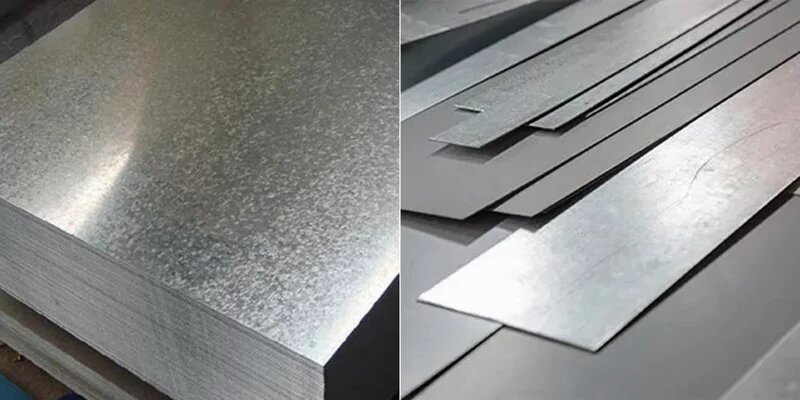
Was ist verzinkter Stahl?
Verzinkter Stahl ist Stahl, der mit Zink beschichtet ist, um Rost zu verhindern. Diese Beschichtung wird durch Eintauchen des Stahls in geschmolzenes Zink aufgebracht. Die Zinkschicht bedeckt die Oberfläche und verhindert, dass Feuchtigkeit und Luft den darunter liegenden Stahl erreichen.
Die Zinkschicht schützt das Metall. Wenn die Oberfläche zerkratzt wird, bekämpft das Zink immer noch den Rost, indem es sich selbst zuerst aufgibt. Dies wird als Opferschutz bezeichnet.
Der Prozess beginnt mit der Reinigung des Stahls. Schmutz und Öl werden entfernt, damit das Zink gut haften kann. Dies kann durch Eintauchen in geschmolzenes Zink oder durch Auftragen der Beschichtung mit elektrischem Strom geschehen.
Der Galvanisierungsprozess
Die Verzinkung schützt den Stahl durch das Aufbringen einer Zinkschicht. Diese Schicht verhindert, dass Feuchtigkeit und Sauerstoff an den Stahl gelangen. Es gibt zwei Möglichkeiten, das Zink aufzutragen.
Feuerverzinkung
Bei diesem Verfahren wird der Stahl in ein Bad aus geschmolzenem Zink bei großer Hitze getaucht. Das Zink verbindet sich mit dem Stahl und bildet eine dicke, raue Schicht. Sie bildet einen starken Schutz und bedeckt den Stahl gleichmäßig, auch an Kanten und Ecken.
Die Beschichtung hat eine glänzende, schillernde Oberfläche. Sie hält harten Bedingungen wie Regen, Schnee und salzhaltiger Luft stand und wird häufig für Außen- oder Schwerlastanwendungen eingesetzt.
Galvanische Verzinkung
Bei der elektrolytischen Verzinkung wird das Zink mit Hilfe von Elektrizität auf den Stahl aufgebracht. Dabei entsteht eine dünnere, glattere Beschichtung mit einem gleichmäßigeren Aussehen.
Diese Methode ermöglicht eine bessere Kontrolle der Schichtdicke. Es eignet sich für Projekte, bei denen es auf das Aussehen ankommt oder bei denen die Teile eng zusammenpassen müssen. Es bietet jedoch eine geringere Korrosionsbeständigkeit als das Schmelztauchen.
Hauptmerkmale von verzinktem Stahl
- Widerstandsfähig gegen Rost: Die Verzinkung schützt den Stahl vor Feuchtigkeit.
- Langlebigkeit: Die Zinkschicht kann Schläge einstecken und schützt den Stahl trotzdem.
- Geringe Kosten: Es ist billiger als Edelstahl und schützt trotzdem gut.
- Glänzende Oberfläche: Das glitzernde Aussehen macht es an sichtbaren Stellen attraktiv.
- Wartungsfrei: Nach der Beschichtung sind nur selten Nachbesserungen oder Reparaturen erforderlich.
Typische Anwendungsfälle
- Strukturen im Freien: Zäune, Leitplanken, Straßenschilder
- Baumaterialien: Dacheindeckung, Stahlskelettbau, Dachrinnen
- Landwirtschaftliche Werkzeuge: Getreidesilos, Wassertanks, Anhänger
- Autoteile: Teile des Fahrgestells, die Schmutz und Wasser ausgesetzt sind
- HVAC-Kanäle: Wo Feuchtigkeitsbeständigkeit in Innenräumen wichtig ist
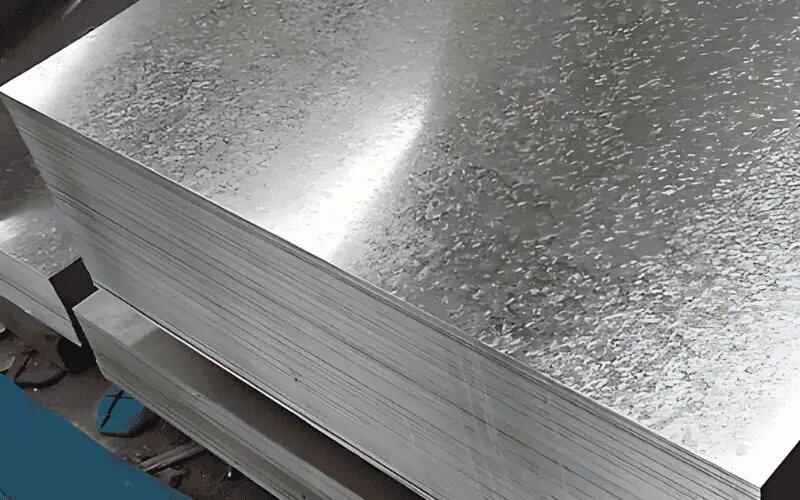
Was ist galvanisierter Stahl?
Galvanisch verzinkter Stahl ist Stahl, der verzinkt und anschließend wärmebehandelt wurde. Durch dieses Verfahren wird die Oberfläche so verändert, dass sie härter wird und sich besser lackieren lässt.
Galvanisch verzinkter Stahl wird auf die gleiche Weise hergestellt wie verzinkter Stahl. Der Stahl wird in ein Bad aus geschmolzenem Zink getaucht, um eine Schutzschicht aufzutragen.
Danach durchläuft er einen weiteren Schritt. Der beschichtete Stahl wird erneut auf etwa 500-565 °C erhitzt. Durch diese Hitze vermischen sich Zink und Eisen und bilden eine neue Oberflächenschicht aus einer Zink-Eisen-Legierung.
Diese Legierung macht die Oberfläche stumpfgrau und rauer als normaler verzinkter Stahl. Sie glänzt nicht, ist aber fester und lässt sich leichter lackieren. Das macht verzinkten Stahl zu einer besseren Wahl, wenn Teile lackiert werden sollen, gebildet, oder geschweißt.
Bildung von Zink-Eisen-Legierungsschichten
Während der Wärmebehandlung reagiert der Zinküberzug mit der Stahloberfläche. Dadurch entsteht eine Reihe von Schichten aus einer Zink-Eisen-Legierung. Diese Schichten sind fest mit dem Stahl verbunden.
Im Gegensatz zu normalem verzinktem Stahl befindet sich diese Beschichtung nicht nur auf der Oberfläche. Sie wird Teil der äußeren Schicht des Stahls. Deshalb hat galvanisierter Stahl eine gleichmäßigere und matte Oberfläche. Außerdem ist er resistent gegen Abblättern beim Umformen oder Schweißen.
Wichtige Eigenschaften von galvanisiertem Stahl
- Lackierbarkeit: Die raue Oberfläche hält die Farbe gut ohne zusätzliche Vorbereitung.
- Kratzfest: Die harte Zink-Eisen-Schicht ist resistent gegen Beschädigungen bei der Handhabung.
- Schweißbarkeit: Es schweißt sauberer als verzinkter Stahl und hat weniger Spritzer.
- Kein Abblättern: Die Beschichtung bleibt beim Biegen oder Umformen an Ort und Stelle.
- Matte Oberfläche: Eine stumpfgraue Oberfläche ist ideal für Farbe oder Pulverbeschichtung.
Gemeinsame Anwendungsbereiche
- Fahrzeugverkleidungen: Türen, Motorhauben, Rahmen, die lackiert werden müssen und gegen Beulen geschützt werden müssen
- Geräte: Waschmaschinen- und Trocknergehäuse, Schalttafeln
- Industrielle Ausrüstung: Schränke, Gehegeund Gehäusen
- Konstruktionsteile: Innenausbau, Türrahmen, Trennwände
- Elektrische Kästen: Lackierte Platten und Abzweigdosen in Innenräumen verwendet
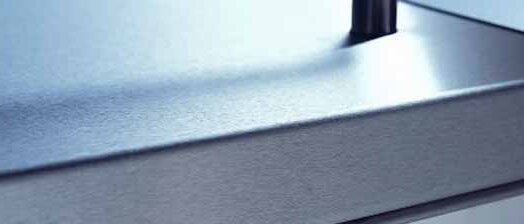
Hauptunterschiede zwischen galvanisiertem und verzinktem Stahl
Beide Beschichtungen schützen Stahl vor Rost, verhalten sich aber in der Praxis unterschiedlich. Die Unterschiede ergeben sich aus der Art der Herstellung und dem Verhalten nach der Verarbeitung.
Zusammensetzung und Struktur der Beschichtung
Verzinkter Stahl hat eine reine Zinkschicht auf der Oberfläche. Das Zink wird während des Tauchvorgangs hinzugefügt und bleibt auf der Oberfläche.
Galvanisch verzinkter Stahl beginnt ebenfalls mit einem Zinküberzug. Er durchläuft jedoch einen zweiten Erhitzungsschritt. Durch diese Hitze wird das Eisen aus dem Stahl in die Zinkschicht gezogen. Das Ergebnis ist eine Zink-Eisen-Legierung, die härter ist und sich besser mit der Oberfläche verbindet.
Korrosionsbeständigkeit im Vergleich
Verzinkter Stahl bietet einen besseren Korrosionsschutz, insbesondere im Freien oder in feuchter Umgebung. Seine dicke Zinkschicht wirkt wie eine starke Barriere.
Galvanisch verzinkter Stahl hat eine dünnere Beschichtung. Sie schützt zwar immer noch vor Rost, ist aber besser für den Innenbereich oder für Teile geeignet, die lackiert werden.
Aussehen
Verzinkter Stahl glänzt und hat ein schillerndes, strukturiertes Aussehen. Er wird oft dort verwendet, wo es auf das Aussehen ankommt.
Galvanisch verzinkter Stahl ist mattgrau. Die einheitliche und stumpfe Oberfläche macht es einfach zu streichen, ist aber weniger attraktiv, wenn sie unbehandelt bleibt.
Umformbarkeit und Schweißeignung
Verzinkter Stahl kann abplatzen oder abblättern, wenn er zu stark gebogen wird. Die Beschichtung kann unter Belastung reißen.
Galvanisch verzinkter Stahl hat eine härtere Beschichtung, die an Ort und Stelle bleibt. Er lässt sich besser formen und schweißen. Es gibt weniger Beschichtungsverluste, und bei Schweißarbeiten entstehen weniger Dämpfe oder Spritzer.
Kosten
Verzinkter Stahl ist in der Regel billiger. Er erfordert nur einen Schritt - die Verzinkung - und wird in größeren Mengen hergestellt.
Galvanisch verzinkter Stahl ist wegen der zusätzlichen Wärmebehandlung teurer. Diese zusätzlichen Kosten können jedoch Zeit sparen und die Lackier- oder Schweißergebnisse verbessern.
Galvanisch geglühter vs. verzinkter Stahl: Pro und Kontra
Jede Beschichtung hat klare Stärken und Nachteile. Ihre Entscheidung sollte den Anforderungen an die Oberfläche, dem Budget und dem Arbeitsablauf Ihres Projekts entsprechen.
Vorteile von verzinktem Stahl
- Starker Rostschutz, besonders im Außenbereich
- Geringere Kosten im Vergleich zu Galvannealed
- Glänzende Oberfläche mit dekorativer Wirkung
- Stärker dehnbar, leichter zu biegen oder zu formen
- Leicht erhältlich in vielen Größen und Formen
Nachteile von verzinktem Stahl
- Ohne Vorbereitung der Oberfläche kann die Farbe abblättern oder nicht gut haften.
- Beschichtung kann beim Schweißen oder Umformen abblättern
- Das verschnörkelte Aussehen passt nicht zu sauberen oder einheitlichen Oberflächen
- Weniger geeignet für Punktschweißen
- Kann sich mit der Zeit in feuchten Umgebungen verfärben
Vorteile von galvanisiertem Stahl
- Farbe haftet besser ohne zusätzliche Oberflächenvorbereitung
- Matte Oberfläche bietet eine glatte Grundlage für Beschichtungen
- Die Beschichtung blättert beim Schweißen oder Umformen nicht ab
- Hält sich gut im industriellen Inneneinsatz
- Oberfläche widersteht Kratzern besser als verzinkter Stahl
Nachteile von galvanisiertem Stahl
- Schwächere Korrosionsbeständigkeit, wenn sie nicht gestrichen wird
- Geringfügig teurer
- Eine härtere Beschichtung kann bei manchen Umformarbeiten spröder sein.
- Ein stumpfes Aussehen passt möglicherweise nicht zu dekorativen Teilen
- Weniger verbreitet als verzinkt, daher möglicherweise längere Lieferzeiten
Wie wählt man zwischen galvanisch verzinkt und verzinkt?
Die Wahl der richtigen Stahlbeschichtung hängt davon ab, wo und wie Sie das Metall verwenden wollen. Jede Option ist für eine andere Art von Projekt geeignet.
Wird das Teil lackiert?
Wenn Sie vorhaben, das Teil zu lackieren, ist verzinkter Stahl die bessere Wahl. Seine Oberfläche hält die Farbe gut, ohne abzublättern, und die matte Oberfläche bietet eine starke Haftung ohne zusätzliche Vorbereitung.
Verzinkter Stahl kann ebenfalls lackiert werden, muss aber vorher oberflächenbehandelt werden. Die glatte, ölige Beschichtung kann die Farbe abblättern lassen, wenn sie nicht gereinigt und entsprechend grundiert wird.
Ist das Projekt für den Außenbereich gedacht?
Verzinkter Stahl ist für den Außeneinsatz länger haltbar. Die dickere Zinkschicht schützt besser vor Rost und Witterungseinflüssen. Selbst wenn sie zerkratzt wird, schützt sie den darunter liegenden Stahl noch.
Galvanisch verzinkter Stahl ist im Freien nicht so gut, wenn er nicht vollständig lackiert und versiegelt ist. Die dünnere Beschichtung nutzt sich bei Regen oder hoher Luftfeuchtigkeit schneller ab.
Wird das Teil geschweißt oder geformt?
Galvanisch verzinkter Stahl ist besser zum Schweißen und Umformen geeignet. Seine Beschichtung reißt nicht und blättert bei der Formgebung nicht ab, und die Zink-Eisen-Schicht bleibt unter Hitze und Druck stabil.
Verzinkter Stahl kann an Schweiß- oder Biegepunkten abplatzen, und die reine Zinkschicht kann Blasen werfen oder sich ablösen, wenn sie zu heiß wird oder gedehnt wird.
Brauchen Sie ein sauberes, einheitliches Erscheinungsbild?
Galvanisierter Stahl bietet eine glatte, lackierfertige Oberfläche. Er eignet sich am besten für sichtbare Teile, die eine saubere Oberfläche oder eine individuelle Farbe benötigen.
Verzinkter Stahl hat ein schillerndes, glänzendes Aussehen. Er eignet sich für freiliegende Strukturteile, ist aber nicht immer ideal für Teile, die eine einheitliche Farbe oder Textur benötigen.
Schlussfolgerung
Verzinkter Stahl bietet einen besseren Schutz gegen Rohkorrosion und eignet sich gut für den Außeneinsatz. Galvanisch verzinkter Stahl eignet sich besser für lackierte Teile, den Einsatz in Innenräumen und schweißintensive Arbeiten. Die richtige Wahl hängt von den Anforderungen an die Oberfläche, dem Arbeitsverfahren und dem Verwendungsort des Teils ab.
Brauchen Sie Hilfe bei der Auswahl des besten Stahls für Ihr nächstes Projekt? Nennen Sie uns Ihren Anwendungsfall; wir empfehlen Ihnen die richtige Beschichtung und Oberfläche für Ihre Anforderungen. Nehmen Sie jetzt Kontakt mit uns auf, um ein schnelles, fachkundiges Angebot zu erhalten.
Hey, ich bin Kevin Lee

In den letzten 10 Jahren bin ich in verschiedene Formen der Blechbearbeitung eingetaucht und teile hier coole Erkenntnisse aus meinen Erfahrungen in verschiedenen Werkstätten.
Kontakt aufnehmen

Kevin Lee
Ich verfüge über mehr als zehn Jahre Berufserfahrung in der Blechverarbeitung und bin auf Laserschneiden, Biegen, Schweißen und Oberflächenbehandlungstechniken spezialisiert. Als Technischer Direktor bei Shengen bin ich bestrebt, komplexe Fertigungsherausforderungen zu lösen und Innovation und Qualität in jedem Projekt voranzutreiben.

